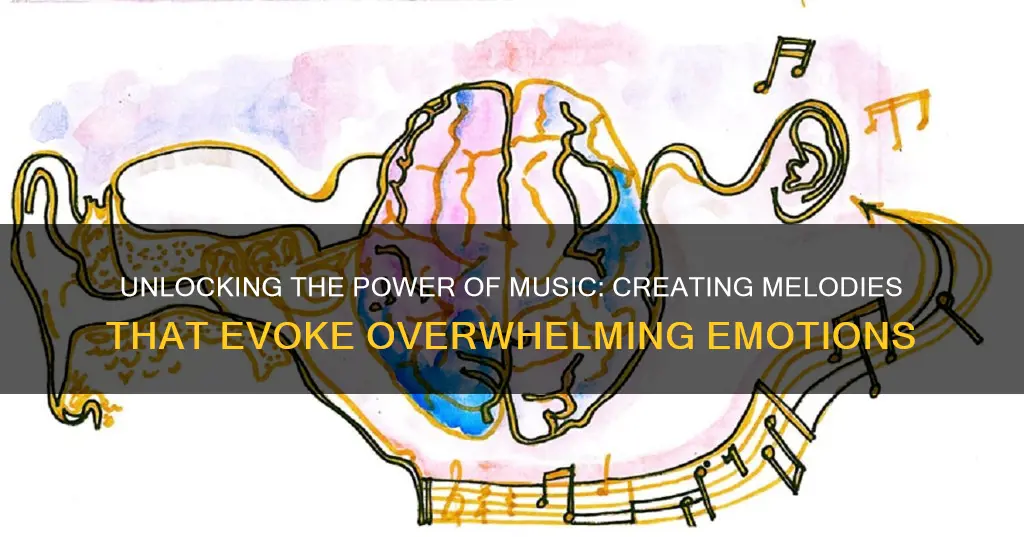
The power of music lies within its ability to evoke intense emotions within us, to transport us to places we've never been, and touch upon feelings we can't quite put into words. Creating music that elicits overwhelming emotions is a true art form, requiring a delicate balance of technical skill, personal connection, and the courage to delve into the depths of our own souls. It is in these moments, when music becomes an outpouring of raw, unfiltered emotion, that we can truly connect with others and touch their hearts in ways we never thought possible. So, if you're ready to embark on a journey of self-discovery and create music that leaves a lasting impact, then let's dive into the world of overwhelming emotions in music creation.
| Characteristics | Values |
|---|---|
| Lyrics | Deep |
| Melody | Expressive |
| Dynamics | Intense |
| Chord Progressions | Emotionally powerful |
| Instrumentation | Evocative |
| Tempo | Dramatic |
| Harmony | Haunting |
| Rhythm | Heartfelt |
| Vocals | Passionate |
| Production Quality | Raw |
What You'll Learn

Setting the Mood with Melody and Harmony
Music has the incredible power to evoke emotions and transport us to different emotional landscapes. As a composer or songwriter, you have the ability to set the mood and create an emotional journey for your listeners. One of the key elements in achieving this is choosing the right key and tempo for your piece.
When choosing the key of a composition, it's important to consider the emotional impact that different keys can have. Each key has its own unique characteristics and associations. For example, major keys are generally perceived as more uplifting and joyful, while minor keys tend to sound more sad and melancholic. However, it's important to note that these associations can vary depending on cultural and personal experiences.
To choose the right key, start by considering the overall mood and emotional message you want to convey. If you want to create a happy and uplifting piece, choosing a major key such as C major or G major might be a good starting point. On the other hand, if you want to create a darker and more dramatic atmosphere, consider using a minor key like A minor or D minor.
Once you've chosen the key, the next step is to select the appropriate tempo. The tempo of a piece refers to the speed at which it is played. Just like keys, different tempos can elicit different emotional responses from the listeners. A slow tempo, such as largo or adagio, can create a sense of calmness and contemplation. On the other hand, a fast tempo, like allegro or presto, can evoke feelings of excitement and energy.
To choose the right tempo, consider the overall mood and energy level you want to convey. If you're aiming for a peaceful and introspective piece, a slower tempo might be more fitting. However, if you're trying to create a sense of urgency or excitement, a faster tempo can help accomplish that.
It's important to note that there are no hard and fast rules when it comes to choosing the right key and tempo. These are just guidelines that can help you get started and serve as a foundation for your creative decisions. Ultimately, the key and tempo should be chosen based on your artistic vision and the emotional message you want to convey.
Creating Melodies that Evoke Emotion
One of the most powerful tools in setting the mood and evoking emotions through music is melody. A captivating melody can move listeners and stir their emotions in profound ways. Creating melodies that evoke specific emotions requires careful attention to musical elements such as pitch, rhythm, and phrasing.
Pitch is an essential element in creating emotional melodies. Choosing specific notes and intervals can greatly influence the emotional response of the listener. For instance, higher pitched notes can convey a sense of excitement and positivity, while lower pitched notes can evoke feelings of sadness and depth. Experiment with different pitches to find the ones that best communicate the emotions you want to convey.
Rhythm plays a crucial role in shaping the emotional quality of a melody. The rhythmic patterns you choose can create a sense of tension or release, urgency or relaxation. Syncopation, for example, can add energy and excitement, while sustained notes can introduce a feeling of calmness or anticipation. Explore various rhythmic patterns to find the ones that resonate with the emotions you want your melody to evoke.
Phrasing is another important element to consider when creating emotionally engaging melodies. Phrases are musical sentences that contain a beginning, middle, and end. By carefully shaping the length and contour of your phrases, you can create tension, release, and emotional impact. Consider using longer phrases for a more contemplative or dramatic mood, and shorter phrases for a sense of urgency or excitement.
Experiment with these elements, and don't be afraid to take risks and explore different combinations. Trust your instincts and let the emotional message guide your creative choices. Remember that practice and experimentation are key to honing your skills in creating emotionally evocative melodies.
Orchestrating Harmonic Progressions for Maximum Impact
Harmony is a powerful tool that can greatly enhance the emotional impact of your compositions. By choosing and arranging chords in a thoughtful and intentional way, you can create harmonic progressions that evoke specific emotions and set the mood for your piece.
When orchestrating harmonic progressions, it's important to consider the emotional qualities of different chords. Major chords are generally associated with happiness and joy, while minor chords convey sadness and melancholy. However, it's important to note that the emotional impact of chords can also be influenced by their context within the overall harmonic progression.
To create harmonies that have maximum impact, consider using chords that create tension and resolution. Tension can be created by using chords that are dissonant or unstable, while resolution can be achieved by using chords that are consonant or stable. By carefully balancing tension and release in your harmonic progressions, you can create a captivating emotional journey for the listener.
Consider the order and timing of chord changes as well. The rate at which chords change can greatly influence the emotional quality of a piece. A faster rate of chord changes can create a sense of excitement and energy, while a slower rate can evoke a more contemplative or melancholic mood. Experiment with different chord progressions and their timing to find the ones that convey the emotions you want to evoke.
Finally, consider the instrumentation and arrangement of your harmonic progressions. Different instruments and textures can greatly enhance the emotional impact of your harmonies. For example, using a full orchestra can create a powerful and grandiose sound, while a solo piano can convey a more intimate and introspective mood. Experiment with different arrangements to find the instrumentation that best complements your emotional message.
In conclusion, choosing the right key and tempo, creating emotionally evocative melodies, and orchestrating harmonic progressions are essential skills for setting the mood and evoking emotions through music. Paying attention to the emotional qualities of these musical elements and experimenting with various combinations will help you create impactful and moving compositions that resonate with listeners. Remember that practice, experimentation, and trusting your artistic instincts are key to mastering these techniques.
Exploring the Emotional Intelligence of Horses: Understanding Their Incredible Bond with Humans
You may want to see also

Crafting Evocative Lyrics and Storytelling
Great song lyrics have the power to transport listeners to a different place and evoke strong emotions. Crafting evocative lyrics often involves tapping into personal experiences, using metaphors and symbolism, and building a narrative arc. In this blog post, we will explore each of these techniques in detail, and provide useful tips on how to incorporate them into your songwriting.
Tapping into personal experiences is fundamental to creating authentic and emotionally resonant lyrics. Drawing from your own life allows you to infuse your songs with genuine feelings and experiences. Start by reflecting on significant moments, relationships, or emotions that have had a profound impact on you. Consider how you can use these personal experiences to tell a larger story or explore universal themes.
To effectively tap into personal experiences, it's important to be open and honest with yourself. Don't shy away from exploring your own vulnerabilities or expressing genuine emotions. Take the time to fully process your experiences before attempting to write about them. This will help you connect with the deeper emotions that will resonate with your listeners.
In addition to personal experiences, incorporating metaphors and symbolism can elevate your lyrics and add layers of meaning. Metaphors are powerful tools that allow you to convey complex emotions and concepts using vivid imagery. For example, instead of directly stating that you're heartbroken, you could use metaphors like "my heart is a shattered glass" or "love is a crumbling bridge." By using metaphors, you invite listeners to interpret your lyrics in their own unique ways, fostering a deeper connection with your music.
Symbolism, on the other hand, involves using objects, actions, or settings to represent abstract ideas or emotions. For instance, a broken clock can symbolize the end of a relationship or the passage of time. Symbolism adds depth and richness to your lyrics, allowing listeners to engage with your music on a deeper level.
Building a narrative arc is another essential aspect of crafting evocative lyrics. A narrative arc is the progression of a story or concept throughout the song. It helps create a sense of structure and coherence, guiding listeners through the emotional journey your lyrics are taking them on.
To build a narrative arc, start by establishing a clear beginning, middle, and end. Your song should have an introduction that grabs the listener's attention, develops in the middle with rising tension or emotions, and resolves in a satisfying and meaningful way. Consider how you can use pacing, dynamics, and lyrical choices to mirror the emotional trajectory of your story.
Furthermore, incorporating elements of conflict, tension, and resolution can add depth and captivate your audience. Think about the conflicts or obstacles that your song's protagonist might face and how they overcome them. This will make your lyrics more relatable and engaging for listeners.
In conclusion, crafting evocative lyrics and storytelling requires tapping into personal experiences, using metaphors and symbolism, and building a narrative arc. By drawing from your own life, employing vivid imagery, and creating a coherent story structure, you can create songs that resonate deeply with your audience. Embrace the power of storytelling and watch as your lyrics come to life.
Finding Strength: How to Respond to an Emotionally Abusive Partner
You may want to see also

Enhancing Emotion through Instrumentation and Production
In the realm of music production, creating emotions through instrumentation and production is a fundamental aspect. By carefully selecting the right instruments and sounds, utilizing dynamics and soundscapes, and experimenting with production techniques, musicians and producers can evoke the desired emotional response in their audience. In this blog post, we will explore these three key elements and provide valuable insights on how to enhance emotion in your music.
Selecting the Right Instruments and Sounds:
When it comes to selecting instruments and sounds, the choices you make greatly impact the emotional resonance of your music. Here are a few tips to guide you:
A. Research and choose instruments with emotional associations. Different instruments have unique emotional qualities that can help convey specific moods. For example, pianos often create a sense of melancholy, while brass instruments can add power and excitement. Consider the emotional nuances of various instruments and include them strategically in your arrangements.
B. Experiment with unconventional instruments. Sometimes, going beyond traditional instruments can add a distinct emotional touch to your music. Explore the world of electronic instruments or experiment with unconventional objects to create unique sounds that resonate emotionally with your audience.
C. Pay attention to timbre and texture. The timbre and texture of an instrument or sound greatly impact emotional depth. Experiment with different playing techniques, effects, and sonic treatments to shape the timbre and texture of your chosen instruments. This allows you to accentuate or soften certain emotions within your music.
Utilizing Dynamics and Soundscapes:
Dynamics play a crucial role in evoking emotion in music. Understanding how to effectively use dynamics and create rich soundscapes is essential. Consider the following aspects:
A. Build tension and release. By incorporating dynamic contrast, you can effectively build tension and release, which enhances emotional impact. Gradually increasing the intensity of a section or introducing sudden pauses can create suspense and release, engaging the listener emotionally.
B. Explore contrasting soundscapes. Using different layers, textures, and panning techniques, you can create contrasting soundscapes within your music. Contrasting soundscapes allow for the depiction of conflicting emotions, tension, or even moments of calmness and tranquility. Experiment with these techniques to create depth and complexity in your arrangements.
C. Leverage space and silence. Sometimes, the absence of sound can be just as impactful as its presence. By intentionally creating moments of space and silence, you can emphasize particular emotions or provide clarity within your music. Experiment with strategic pauses or minimalist sections to evoke emotional responses.
Experimenting with Production Techniques:
The production stage offers endless opportunities to enhance the emotional impact of your music. Here are a few production techniques to consider:
A. Vocal processing. The human voice is a powerful emotional instrument. Experiment with different vocal processing techniques, such as harmonies, pitch modulation, and reverberation, to evoke specific emotional responses. Vocal effects can add depth and intensity to the lyrics and overall mood of your song.
B. Reverb and spatial effects. Utilize reverb and spatial effects to create a sense of depth and space within your mix. By carefully adjusting the parameters of these effects, you can manipulate the listener's perception, allowing for more immersive and emotionally-charged experiences.
C. Creative automation. Automation allows for dynamic changes in various parameters, such as volume, panning, and effects. Experiment with automation to introduce subtle or dramatic shifts, highlighting key emotional moments in your music. Creative automation techniques can add intrigue and impact to your compositions.
Ending a Phone Call Abruptly: Is It Emotional Abuse?
You may want to see also

Imbuing the Music with Passion and Authenticity
In music, the ability to evoke emotions and connect with listeners on a deep level is paramount. Whether it's through powerful vocals or captivating instrumental performances, pouring emotion into music is an art that can truly transform a song. By infusing energy and feeling and prioritizing honest and genuine expressiveness, musicians can create an authentic and unforgettable musical experience.
Pouring Emotion into Vocal Delivery:
- Understand the lyrics and their meaning: Before delving into vocal delivery, it's crucial to understand the lyrics and their underlying emotions. Take the time to dissect the words and grasp the intended message. This will give you a solid foundation from which to pour emotion into your vocal performance.
- Connect with personal experiences: To truly convey emotion in your vocals, draw upon your personal experiences and emotions that align with the song's theme. Tap into those feelings and let them guide your delivery. This authenticity will resonate with listeners and make your performance more relatable.
- Experiment with vocal techniques: Vocal techniques such as dynamics, pitch modulation, and vibrato can add depth and emotion to your delivery. Experiment with different techniques and find the ones that complement the emotional range you want to convey. Remember to maintain control and balance, as excessive embellishments can detract from the authenticity of the performance.
- Focus on phrasing and articulation: Pay attention to the phrasing and articulation of the lyrics. This will allow you to emphasize certain words or phrases and create a more impactful delivery. Be conscious of the emotional impact each phrase should have and adjust your delivery accordingly.
Infusing Energy and Feeling into Instrumental Performances:
- Internalize the melody: To infuse energy and feeling into instrumental performances, internalize the melody and immerse yourself in its emotional landscape. Understand how each note contributes to the overall mood of the piece. By feeling the music deeply, you'll be able to transmit that energy and emotion through your instrument.
- Experiment with dynamics: Dynamics play a crucial role in conveying emotion in instrumental performances. Experiment with volume, tone, and intensity to create contrasting dynamics that reflect the emotions you want to express. Soft and delicate passages can evoke vulnerability, while powerful and bold sections can convey intensity and passion.
- Incorporate expressive techniques: Explore expressive techniques specific to your instrument, such as bends, slides, vibrato, and glissandos. These techniques allow you to add nuance and emotional depth to your performance. Learn to use them judiciously and purposefully, creating moments of heightened emotional impact.
- Pay attention to phrasing: Like in vocal delivery, phrasing is essential in instrumental performances. Deliberate and well-executed phrasing can elevate the emotional impact of your playing. Consider the overall structure of the melody, and use pauses, legato phrasing, and accents to highlight the emotional peaks and valleys of the piece.
Prioritizing Honest and Genuine Expressiveness:
- Be authentic: The most important aspect of pouring emotion into music is being authentic. Don't try to imitate other artists or force emotions that don't resonate with you. Instead, focus on expressing your true self and letting your genuine emotions guide your performance. This sincerity will shine through and captivate your audience.
- Connect with the music: To prioritize honest and genuine expressiveness, forge a deep connection with the music you're performing. Understand its context, history, and emotional purpose. By immersing yourself in the music's significance, you'll be better equipped to infuse it with the necessary emotions.
- Practice mindfulness: Prioritize emotional awareness and mindfulness during your practice sessions. Be present in the moment and attuned to your emotions. This will enable you to connect with the music on a deeper level and translate that connection into your performance.
- Let go of inhibitions: To truly express oneself, it's important to let go of inhibitions and fears of judgment. Embrace vulnerability and allow yourself to fully immerse in the emotions you want to convey. This fearless attitude will not only enhance your expressiveness but also inspire others to connect with your music.
In conclusion, pouring emotion into music requires a combination of understanding, technique, authenticity, and mindfulness. By prioritizing honest and genuine expressiveness, musicians can create performances that touch the hearts of listeners. Whether through vocals or instrumental performances, remember to connect with the lyrics or melody, experiment with techniques, and let your emotions guide your delivery. Embrace the power of music to evoke emotions, and you will undoubtedly create an authentic and passionate musical experience.
Why Emotional Intelligence is Crucial for Success in Sports
You may want to see also
Frequently asked questions
To create music that shows overwhelming emotions, you can start by choosing a key or scale that matches the mood or emotion you want to convey. Minor keys are often associated with sadness or intensity, while major keys can evoke happiness or excitement. Experiment with different chord progressions and melodies that elicit strong emotions for you personally.
There are several techniques you can use to convey intense emotions in your music. One technique is to use dynamic contrast, which involves incorporating both soft and loud sections in your composition to create tension and release. You can also experiment with tempo changes, using faster or slower rhythms to enhance the emotional impact of your music.
When writing lyrics, focus on using descriptive language that paints vivid images and evokes strong emotions. Utilize metaphor and symbolism to convey complex emotions that may be hard to express directly. Additionally, consider the rhythmic flow and delivery of your lyrics, as the timing and phrasing can greatly enhance the emotional impact of your words.
Instrumentation can play a crucial role in conveying overwhelming emotions. Experiment with different instruments and sounds to find ones that resonate with the emotions you want to express. For example, using string instruments like violins or cellos can add a sense of melancholy or intensity to your music. Focus on creating layers and textures in your arrangement to enhance the emotional depth of your composition.
Absolutely! Drawing from personal experiences and memories is a powerful way to inject authenticity and emotional depth into your music. Reflect on past experiences that have stirred up overwhelming emotions for you, and try to translate those feelings into melodies, lyrics, or musical motifs. By tapping into your own emotional landscape, you can create music that resonates with others on a deep level.







